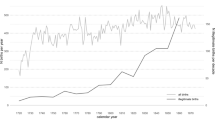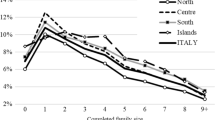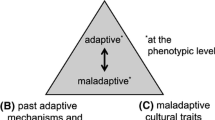Abstract
Extrinsic mortality is a key influence on organisms’ life history strategies, especially on age at maturity. This historical longitudinal study of 125 women in rural Domenica examines effects of extrinsic mortality on human age at maturity and pace of reproduction. Extrinsic mortality is indicated by local population infant mortality rates during infancy and at maturity between the years 1925 and 2000. Extrinsic mortality shows effects on age at first birth and pace of reproduction among these women. Parish death records show huge historical variation in age-specific mortality rates. The infant mortality rate (IMR) in the early 1920s was low, increased dramatically beginning in 1929, and reached a maximum in the 1950s, at which point IMR declined steadily to its present low rate. The mortality rate early in life showed a quadratic association with age at first birth. Women who experienced conditions of low IMR early in life reproduced relatively late in life. Those born into moderately high levels of infant mortality tended to reproduce earlier than those born at low levels. At very high infant mortality levels early in life, women went on to delay reproduction until relatively late, possibly as a result of somatic depletion and energetic stress associated with the conditions that lead to high IMR. Population mortality rates at age of maturity also showed a quadratic association with age at first birth. The pace of reproduction, estimated as number of surviving offspring controlled for maternal age, showed a similar quadratic effect. There were complex interactions between population mortality rates in infancy and at maturity. When extrinsic mortality was high during infancy, extrinsic mortality later in life had little effect on timing of first birth. When extrinsic mortality was low to moderate in infancy, extrinsic mortality later in life had significant effects on adult reproduction. I speculate that these effects are mediated through development of personality facets associated with reproduction.





Similar content being viewed by others
Notes
Because IMR is calculated for birth year and some children were born at midyear or later, we cannot rule out gestational effects as well as effects during early infancy.
References
Aklin, W. M., Lejuez, C. W., Zvolensky, M. J., Kahler, C. W., & Gwadz, M. (2005). Evaluation of behavioral measures of risk taking propensity with inner city adolescents. Behaviour Research and Therapy, 43, 215–228.
Belsky, J., Steinberg, L., & Draper, P. (1991). Childhood experience, interpersonal development, and reproductive strategy: An evolutionary theory of socialization. Child Development, 62, 647–670.
Borgerhoff Mulder, M. (1992). Reproductive decisions. In E. A. Smith & B. Winterhalder (Eds.), Evolutionary ecology & human behavior (pp. 339–374). New York: Aldine de Gruyter.
Charnov, E. L. (1991). Evolution of life-history variation among female mammals. Proceedings of the National Academy of Science, 88, 1134–1137.
Chisholm, J. S. (1993). Death, hope, and sex: Life history theory and the development of reproductive strategies. Current Anthropology, 34, 1–24.
Chisholm, J. (1999a). Death, hope and sex: Steps to an evolutionary ecology of mind and morality. New York: Cambridge University Press.
Chisholm, J. (1999b). Attachment and time preference: Relations between early stress and sexual behavior in a sample of American university women. Human Nature, 10, 51–83.
Chisholm, J. S., Quinlivan, J. A., Petersen, R. W., & Coall, D. A. (2005). Early stress predicts age at menarche and first birth, adult attachment, and expected lifespan. Human Nature, 16, 233–265.
Comings, D. E., Muhleman, D., Johnson, J. P., & MacMurray, J. P. (2002). Parent-daughter transmission of the androgen receptor gene as an explanation of the effect of father absence on age of menarche. Child Development, 73, 1046–1051.
Costa, P. T., & McCrae, R. R. (1992). Revised NEO Personality Inventory (NEO-PI-R) and NEO Five-Factor Inventory (NEO-FFI) professional manual. Odessa: Psychological Assessment Resources.
Donohew, L., Zimmerman, R., Cupp, P. S., Novak, S., Colon, S., & Abell, R. (2000). Sensation seeking, impulsive decision-making, and risky sex: Implications for risk-taking and design of interventions. Personality and Individual Differences, 68, 1079–1091.
Draper, P., & Harpending, H. (1982). Father absence and reproductive strategy: An evolutionary perspective. Journal of Anthropological Research, 38, 255–279.
Elder, G. H., Caspi, A., & Downey, G. (1986). Problem behavior and family relationships: Life course and intergenerational themes. In A. B. Sørensen, F. E. Weinert, & L. R. Sherrod (Eds.), Human development and the life course: Multidisciplinary perspectives (pp. 293–340). Hillsdale: Erlbaum.
Ellis, B. J. (2004). Timing of pubertal maturation in girls: An integrated life history approach. Psychological Bulletin, 130, 920–958.
Ellis, B. J., McFadyen-Ketchum, S., Dodge, K., Pettit, G., & Bates, J. (1999). Quality of early family relationships and individual differences in the timing of pubertal maturation in girls: A longitudinal test of an evolutionary model. Journal of Personality and Social Psychology, 77, 387–401.
Flinn, M. V., Quinlan, R., Coe, K., & Ward, C. (2008). Evolution of the human family. In C. Salmon & T. Shackelford (Eds.), Family relations: An evolutionary perspective (pp. 16–38). Oxford: Oxford University Press.
Gant, L., Heath, K. M., & Ejikeme, G. G. (2009). Early motherhood, high mortality and HIV/AIDS rates in sub-Saharan Afirica. Social Work in Public Health, 24, 39–46. doi:10.1080/19371910802569435.
Gerald, M. S., Higley, S., Lussier, I. D., Westergaard, G. C., Suomi, S. J., & Higley, J. D. (2002). Variation in reproductive outcomes for captive male rhesus macaques (Macaca mulatta) differing in CSF 5-Hydroxyindoleascetic acid concentrations. Brain, Behavior and Evolution, 60, 117–124.
Harpending, H., Draper, P., & Pennington, R. (1990). Cultural evolution, parental care and mortality. In A. C. Swedlund & G. J. Armelgos (Eds.), Disease in populations in transition: Anthropological and epidemiological perspectives (pp. 251–265). New York: Bergin & Garvey.
Honeychurch, L. (1995). The Dominica story: A history of the island. London: Macmillan.
Hoyle, R. H., Fejfar, M. C., & Miller, J. D. (2000). Personality and sexual risk taking: A quantitative review. Journal of Personality, 68, 1203–1231.
Jackson, Y., Frick, P., & Dravage-Bush, J. (2000). Perceptions of control in children with externalizing and mixed behavior disorders. Child Psychiatry & Human Development, 31, 43–58.
Loue, S., Cooper, M., Traore, F., & Fiedler, J. (2004). Locus of control and HIV risk among a sample of Mexican & Puerto Rican women. Journal of Immigrant Health, 6, 155–165.
Low, B. S., Hazel, A., Parker, N., & Welch, K. B. (2008). Influences on women’s reproductive lives: Unexpected ecological underpinnings. Cross-Cultural Research, 42, 201–219.
O’Connor, T. G., Bredenkamp, D., & Rutter, M. (1999). Attachment disturbances and disorders in children exposed to early severe deprivation. Infant Mental Health Journal, 20, 10–29.
Promislow, D. E. L., & Harvey, P. H. (1990). Living fast and dying young: A comparative analysis of life-history variation among mammals. Journal of the Zoological Society of London, 220, 417–437.
Promislow, D. E. L., & Harvey, P. H. (1991). Mortality rates and the evolution of mammal life histories. Acta Oecologica, 12, 119–137.
Quinlan, R. J. (2003). Father-absence, parental care & female reproductive development. Evolution and Human Behavior, 24, 367–390.
Quinlan, M. B. (2004). From the bush: The front line of health care in a Caribbean village. Belmont: Wadsworth.
Quinlan, R. J. (2006). Gender and risk in matrifocal Caribbean community. American Anthropologist, 108, 464–479.
Quinlan, R. J. (2007). Human parental effort and environmental risk. Proceedings of the Royal Society, B: Biological Science, 274, 121–125.
Quinlan, R. J., & Flinn, M. V. (2003). Intergenerational transmission of conjugal stability in a Caribbean village. Journal of Comparative Family Studies, 34, 569–583.
Quinlan, R. J., & Flinn, M. V. (2005). Kinship, sex, and fitness in a Caribbean community. Human Nature, 16, 36–61.
Quinlan, R. J., & Hagen, E. (2008). New genealogy: It’s not just for kinship anymore. Field Methods, 20, 129–154.
Quinlan, R. J., & Quinlan, M. B. (2007). Parenting & cultures of risk: A comparative analysis of infidelity, aggression & witchcraft. American Anthropologist, 109, 164–179.
Robbins, R. N., & Bryan, A. (2004). Relationships between future orientation, impulsive sensation seeking, and risk behavior among adjudicated adolescents. Journal of Adolescent Research, 19, 428–445.
Roff, D. A. (2002). Life history evolution. Sunderland, MA: Sinauer Associates.
Rutter, M. (2007). Proceeding from observed correlation to casual inference: The use of natural experiments. Perspectives on Psychological Science, 2, 377–395.
Rutter, M., & O’Connor, T. (2004). Are there biological programming effects for psychological development? Findings from a study of Romanian adoptees. Developmental Psychology, 40, 81–94.
Rutter, M., Beckett, C., Castle, J., Colvert, E., Kreppner, J., & Mehta, M. (2007). Effects of profound early institutional deprivation. European Journal of Developmental Psychology, 4, 332–350.
Schechter, D. E., & Francis, C. (2010). A life history approach to understanding youth time preference: Mechanisms of environmental risk and uncertainty and attitudes towards risk behavior and education. Human Nature, 21, doi:10.1007/s12110-010-9084-2.
Stearns, S. C. (1992). The evolution of life histories. Oxford: Oxford University Press.
Trobst, K. K., Herbst, J. H., Masters, H. L., & Costa, P. T. (2002). Personality pathways to unsafe sex: Personality, condom use and HIV risk behaviors. Journal of Research in Personality, 36, 117–133.
U.S. Census Bureau (2008). International data base. Available online at www.census.gov/ipc/www/idbnew.html; accessed November 2008.
Vitzthum, V. J. (2001). Why not so great is still good enough: Flexible responsiveness in human reproductive functioning. In P. T. Ellison (Ed.), Reproductive ecology and human evolution (pp. 179–202). New York: Aldine de Gruyter.
Walker, R. S., Gurven, M., Hill, K., Migliano, A., Chagnon, N., De Souza, R., et al. (2006). Growth rates and life histories in twenty-two small-scale societies. American Journal of Human Biology, 18, 295–311.
Werner-Wilson, R. J. (1998). Gender differences in adolescent sexual attitudes: The influence of individual and family factors. Adolescence, 33, 519–531.
Whitham, C. (2002). Bitter rehearsal: British and American planning for a post-war West Indies. Westport: Praeger.
Whiting, B. (1980). Culture and social behavior: A model for the development of social behavior. Ethos, 8, 95–116.
Wilson, M., & Daly, M. (1997). Life expectancy, economic inequality, homicide, and reproductive timing in Chicago neighbourhoods. British Medical Journal, 314, 1271–1281.
Young, T. M., Martin, S. S., Young, M. E., & Ting, L. (2001). Internal poverty and teen pregnancy. Adolescence, 36, 289–304.
Young, T., Turner, J., Denny, G., & Young, M. (2004). Examining external and internal poverty as antecedents of teen pregnancy. American Journal of Health Behavior, 28, 361–373.
Zuckerman, M., & Kuhlman, D. M. (2000). Personality and risk-taking: Common biosocial factors. Journal of Personality, 68, 999–1029.
Acknowledgments
Thanks to the Saint Sauveur Roman Catholic Church for access to St. David Parish historical birth and death records. Thanks to friends in Bwa Mawego (too many to mention here) for their tremendous help with local oral histories and ethnographic interviews. Thanks to Heather Bonander for research assistance with the historical demographic data. Thanks to the Central Statistics Office of the Commonwealth of Dominica for research permission. Thanks to Drs. Marsha Quinlan and Mark Flinn for constant collegial support. This research was funded in part by NSF Cultural Anthropology grant BCS-0650317.
Author information
Authors and Affiliations
Corresponding author
Rights and permissions
About this article
Cite this article
Quinlan, R.J. Extrinsic Mortality Effects on Reproductive Strategies in a Caribbean Community. Hum Nat 21, 124–139 (2010). https://doi.org/10.1007/s12110-010-9085-1
Published:
Issue Date:
DOI: https://doi.org/10.1007/s12110-010-9085-1




